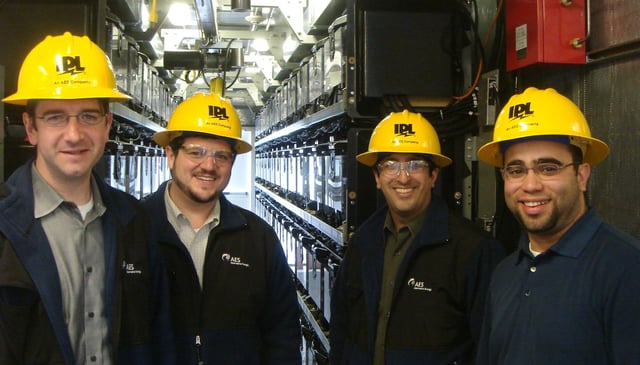When I co-founded the energy storage group at AES ten years ago, advanced energy storage didn’t exist on the grid. The experts thought it was both technically and commercially unfeasible. It was described as the Holy Grail, something of great value, but unobtainable.
With a small, dedicated, and analytic team, we worked with leading power system operators and utilities to challenge that view and delivered a series of valuable, frequently first-of-their-kind, storage applications to markets around the world.

2008: Project Carina in Indianapolis (2 x 1 MW), proof of solution, first grid connected lithium-ion energy storage project in the world.
Today, we are operating with a growing tailwind as utilities and others create new grid-scale storage procurements around the globe. Across the electric power sector, it’s apparent that energy storage will play a pivotal role in the future of the power sector and I am convinced that an open and collaborative approach versus the reliance on a proprietary network is the key to improving lives for all.
Three Lessons from the First 10 Years
The first 10 years of energy storage have made three things clear:
- The early and ongoing debates about the best technology for advanced energy storage are being met by the overwhelming choice of lithium-ion batteries that are now used in nearly every grid-scale energy storage installation. This is driven by many of the characteristics that we first saw in 2007 including scale, life, and efficiency.
- Energy storage systems must be designed to be modular, scalable, and flexible -- viewing a storage system as simply a collection of batteries is an expensive mistake.
- The uses of energy storage will continue to rapidly evolve. During the nine years of operating storage in the PJM Interconnection, we have observed three distinct periods where energy storage systems had to change substantially to meet evolving market performance needs. The right energy storage solution will incorporate characteristics that can adapt to this pace of change to future proof the investment.
With those early technology questions answered as the market has matured over the past decade, we can turn our attention to the next ten years.
Two Dominant Models Are Emerging
As the industry responds to rising demand for grid connected energy storage, we see two dominant models emerging: one marked by open access and collaboration and one by a proprietary approach and vertical integration across the supply chain. The next 10 years will see which model is most effective in scaling up to meet a rapidly growing new demand for energy storage that will enable the transformation of our electric power system.
With wind and solar now cheaper than the variable fuel cost of electricity delivered by thermal plants, combined with rapid price declines in energy storage systems, the market is poised for a historic debate not seen since Thomas Edison and Nicolas Tesla faced off on the usage of a DC or AC electric grid, on how the grid should be modernized. Are we better off by aligning with a proprietary closed network built on a vertically integrated offering or by supporting an open architecture that encourages broader access?
Having just celebrated our ten-year anniversary, we’ve had a moment to reflect on our core, long-held belief of what it will take to continue to drive long-term sustainable growth in the industry and achieve the full potential of the energy network. We believe that utilities will play a central role in this transformation, and by incorporating energy storage, will have the tools available to integrate distributed energy resources, enable community microgrids that interact with the broader network, and facilitate transactions between parties. As with the internet, the new energy network of the future will be based on an architecture that encourages innovation, collaboration, and provides fast and open access for all resources.
Proprietary, vertically-integrated networks create value by simplifying the interface between different parts of the value chain and leveraging other parts of the proprietary ecosystem. For consumer electronics, companies such as Apple have delivered tremendous value by creating an ecosystem for music, personal computing, application development and mobile devices. This can work well for consumer goods in which customers continuously update their devices every several years to ensure the technology continues to support their needs. They can be traded in or recycled for the next model without significant financial ramifications.
Energy assets, similar to other infrastructure assets, are designed to last more than twenty years and cost hundreds of thousands or millions of times more than consumer electronics. When you combine rapid technology developments witnessed in solar photovoltaics and batteries, with high infrastructure costs and long-term investment horizons, an open and collaborative approach clearly becomes favorable to one that locks investment into a single supplier’s design or technology.
Open architecture energy storage will solve big power system problems more quickly. It means that:
- Design is component and company agnostic, enabling different battery cells, chemistries, and even suppliers to operate within a single installation and as part of a cohesive platform. Technology advancements can be integrated as they become available.
- Competition creates efficiencies. There is a large and growing base of key components available for advanced energy storage. By providing a path to common and accessible approaches, we can leverage the existing manufacturing infrastructure of established suppliers to drive out cost.
- A network of collaboration and innovation goes far beyond technology. Transforming a 100-year old system requires different companies and stakeholders to come together. New services and offerings will arise where they didn’t exist before. New partnerships and businesses will deliver ever greater value to customers.
Since the beginning, we have collaborated with customers, suppliers, stakeholders, and sales partners to help move the industry forward with a focus on long-term sustainable growth. The energy industry ten and twenty years from now is being decided today and we plan to do our best to make sure it is one we can all be proud of.

Chris Shelton, John Zahurancik, Praveen Kathpal, and Malaquias Encarnacion at the first energy storage container using Altairnano batteries in 2008.
















